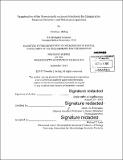| dc.contributor.advisor | Janelle R. Thompson. | en_US |
| dc.contributor.author | Helbig, Timothy J. (Timothy James) | en_US |
| dc.contributor.other | Massachusetts Institute of Technology. Department of Biology. | en_US |
| dc.date.accessioned | 2014-09-19T21:32:52Z | |
| dc.date.available | 2014-09-19T21:32:52Z | |
| dc.date.copyright | 2013 | en_US |
| dc.date.issued | 2013 | en_US |
| dc.identifier.uri | http://hdl.handle.net/1721.1/89988 | |
| dc.description | Thesis: S.M., Massachusetts Institute of Technology, Department of Biology, 2013. | en_US |
| dc.description | Cataloged from PDF version of thesis. | en_US |
| dc.description | Includes bibliographical references (pages 63-71). | en_US |
| dc.description.abstract | Previous work has shown that similar microbial populations are associated with the starlet sea anemone Nematostella vectensis over distinct temporal and geographic locations; however, the functions these bacteria may be performing within their anemone hosts and the mechanisms with which the bacteria may be using to adapt are unknown. To address these issues comparative genomic analysis of ten newly sequenced bacterial isolates from four bacterial populations (Pseudomonas oleovorans, Agrobacterium tumefaciens, Limnobacter thiooxidans and Stappia stellulata) that are associated with Nematostella in the laboratory and/or its natural salt marsh habitat was performed and whole metatranscriptomes of lab-raised N. vectensis were sequenced and analyzed. Comparative genomic analysis revealed the isolates from these bacterial populations to likely be non-clonal, with no evidence that holobiont-specific orthologous groups (i.e. gene orthologs found only in N. vectensis-associated bacterial genomes and absent in closely related genomes of the same genus/family) were shared across the populations examined. Further, no evidence of lateral gene transfer or shared phage or mobile elements among the isolates was observed. Isolate genomes did, however, reveal conserved holobiont specific orthologs within members of the same bacterial population that could be reflective of the ecology of the anemone holobiont; for instance, 3 of the four P. oleovorans isolate genomes showed evidence of holobiont specific antibiotic production, the three A. tumefaciens isolates all shared common ion scavenging proteins and both L. thiooxidans had a holobiont specific antibiotic resistance protein. Whole anemone metatranscriptomic analysis based on BLASTx annotation of sequenced transcripts revealed bacterial expression of housekeeping genes such as those for replication, ribosomal structure and ATP-synthesis dominated by Proteobacteria, in particular Gammaproteobacteria. Further recruitment of the transcripts to sequenced Nematostella associates revealed an active and foraging Limnobacter population expressing genes for signaling, movement, iron scavenging and carbon storage in the form of PHA granules. The similarity of high Limnobacter and host anemone expression for iron regulators suggest iron may be a source of structuring within the anemone holobiont and a good area of further study. | en_US |
| dc.description.statementofresponsibility | by Timothy J. Helbig. | en_US |
| dc.format.extent | 78 pages | en_US |
| dc.language.iso | eng | en_US |
| dc.publisher | Massachusetts Institute of Technology | en_US |
| dc.rights | M.I.T. theses are protected by copyright. They may be viewed from this source for any purpose, but reproduction or distribution in any format is prohibited without written permission. See provided URL for inquiries about permission. | en_US |
| dc.rights.uri | http://dspace.mit.edu/handle/1721.1/7582 | en_US |
| dc.subject | Biology. | en_US |
| dc.title | Examination of the nematostella vectensis holobiont by comparative bacterial genomics and metatranscriptomics | en_US |
| dc.type | Thesis | en_US |
| dc.description.degree | S.M. | en_US |
| dc.contributor.department | Massachusetts Institute of Technology. Department of Biology | |
| dc.identifier.oclc | 890130888 | en_US |
